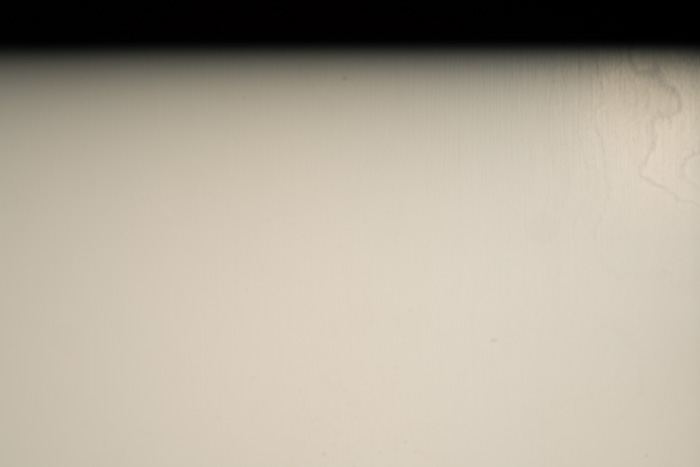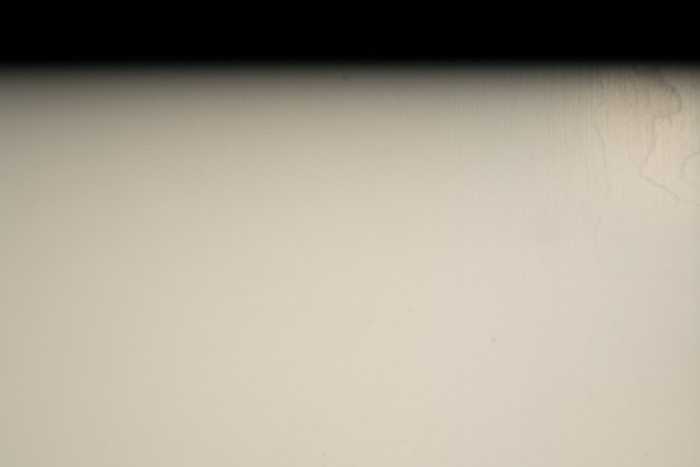There’s a rumor going around that the Sony a7RII’s max synch speed (which is spec’d by Sony as 1/250 second) is reduced if the electronic first-curtain shutter (EFCS) is turned on.
That didn’t sit right with me. Testing seemed called for.
I mounted a Zony 55 on an a7RII and aimed the camera at a white wall in manual exposure mode and the aperture set to f/11 so that I’d get a fairly sharp image of the shutter blade. I connected the hot shoe directly (all copper, no IR or radio synch) to a Paul Buff Einstein and set the flash for a full 640 watt-second dump. I made exposures at 1/320, 1/250, and 1/200 second with EFCS on and off.
Here’s what I got:


Operating at just above the specified synch speed allows us to see how much margin there is in both modes. The EFCS case is slightly better.


Looking at the specified synch speed pictures, it looks like Sony is being a little optimistic when they suggest 1/250 second as the top synch speed. Or is it the flash?


Everything is hunky-dory at 1/200 second, though.
No problem with EFCS affecting synch speed, but what’s with the flash not synching at 1/250 second? For the answer, look here.
did you try with native Sony TTL flashes mounted on A7R2 hotshoe ? because there you have a clean X-Sync @ 1/250, even @ f22… so it seems may be something is not right with your A7R2 -> copper -> Paul Buff 3rd party flash…
I don’t own a Sony flash.
> I don’t own a Sony flash.
well, I as noted in a different comment, even non Sony flash and even fired remotely through a pair of dumb radio triggers (but good quality – Cactus V5) seems can do claimed 1/250 x-sync on Sony A7 w/o that visible blade shade as in your example with Paul Buff strobe hard wired to camera…
I think it may be a power/risetime issue. I’ll do further testing.
The problem turned out to be the flash rise time at high power settings. When I reduced the power, both cameras did OK at their rated maximum synch speeds, both with EFCS on and off.
http://blog.kasson.com/?p=12012
Thanks for commenting.
Jim
on a unrelated topic about zebra showing close to real raw clipping and UniWB:
those who dislike green tint (UniWB), might supplant
WB = UniWB
Creative Style = Neutral (contrast -3, saturation -3, …)
Zebra = 100+
with picture profile like this (no claim that it is the best set of parameters though) :
Gamma = Cine3 (reason : allows ISO below 800 unlike SLog, I tried Cine2 – but Cine3 works better for me)
Knee = Auto
Saturation = -32 (removes green tint with Setting Effect = ON – but then you deal with greyscale image)
Color Mode = S-Gamut
Color Phase = 0
Color Depth = 0s
and (not exactly related to clipping) :
Black Gamma = Wide/+7 (reason : darker areas in fame = brighter)
Black Level = +15 (reason : darker areas in fame = brighter)
I’m afraid I’m guilty of passing on that rumour; just saw your post on DPR and checked and found I was mistaken: now I see I needn’t have bothered as you have done it for us!
I wonder if the original source simply saw that there was a little shading at full sync speed which went away when it was reduced, and attributed it to EFCS without turning off EFCS to check?